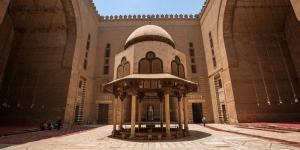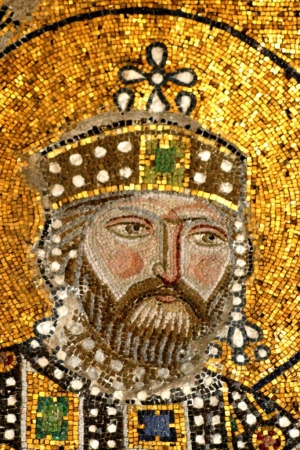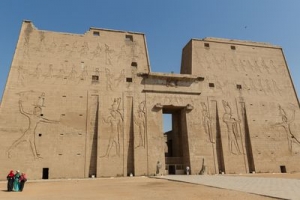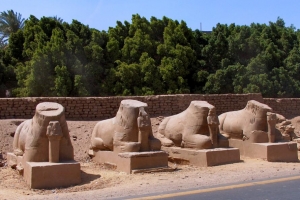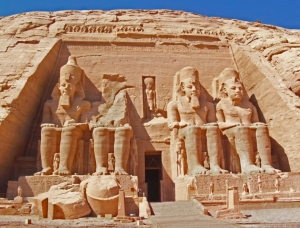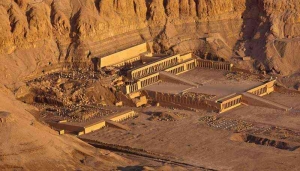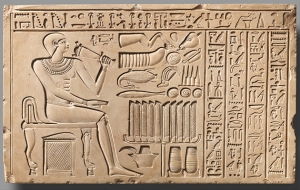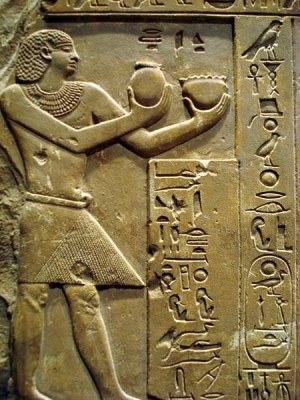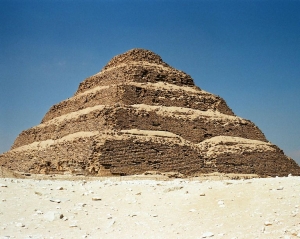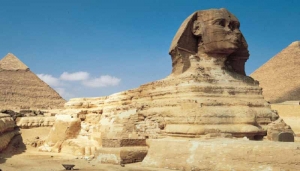+2 0122-345-3028
This email address is being protected from spambots. You need JavaScript enabled to view it.
Super User
The Early Islamic Period
The Early Islamic Period (640-969)
Under the first Khalif of Islam Abu Bakr As-Siddiq, Prophet Muhammad's closest companion, the Muslim armies vanquished the Byzantines in 636 AD. They advanced toward Egypt under the command of Amr Ibn Al-'aas, one of the companions of the Prophet.
The Muslims laid siege to Babylon-in-Egypt, which surrendered. They then took ::I and in 642 AD the Byzantine imperial capital of Alexandria. Amr Ibn Al-'as established Fustat north of Babylon-in-Egypt as his military headquarters and seat of government and the Egyptians swiftly embraced the new religion of Islam.
Egypt became part of an expanding empire that was soon to stretch from Spain to Central Asia. The Ummayyad Dynasty ruled Egypt from Damascus until the Abbasids took control of the Caliphate and shifted the political capital of Islam to Baghdad.
Ahmad Ibn Tulun, who had been sent by the Abbasid Caliph Al-Mu'taz to govern Egypt in 868 AD, declared Egypt an independent state and successfully defended his new domain against the Abbasid armies sent to unseat him. His dynasty ruled Egypt for 37 years. Ibn Tulun built Al-Qitai, a new capital centred around a vast central mosque, the courtyard of which could accommodate his entire army and their horses. But Tulunid rule was quickly ended by the Abbasids, who retained direct control over Egypt until Mohammed Ibn Tughj was appointed governor over the province and granted the title Ikhshid, allowing him to rule independently of Caliphate controls. The Ikhshidi Dynasty ruled from 935-969 AD when Egypt was invaded by Shi'aa Fatimid armies from Tunisia.
Roman and Byzantine Rule
Roman and Byzantine Rule (30BC-AD638)
Octavian Caesar became the first Roman ruler of Egypt, reigning as the Emperor Augustus. Egypt became the granary of the Roman Empire and remained stable for about 30 years. The Romans, like their Greek predecessors, synthesized many Egyptian beliefs with their own, building temples at Dendara and Esna and Tranjan's kiosk at Philae. Hellenism remained a dominant cultural force and Alexandria continued to be a centre of Greek learning.
The Christian era began in Egypt with the spectacular biblical Flight of the Holy Family from Palestine. To this day the stages of the journey of Mary, Joseph and their infant Jesus are marked by shrines and churches. According to Coptic tradition, it was not until the arrival of Saint Mark that Christianity was established in Egypt during the reign of Nero. Saint Mark began preaching the gospel in about AD40 and established the Patriarchate of Alexandria in AD61.
The Egyptian Coptic Church expanded over three centuries in spite of Roman persecution of Christian converts throughout the Empire. In AD202 persecutions against Copts were initiated by the Roman authorities, continuing for nearly a century. In AD284, during the reign of the Emperor Diocletian, a bloody massacre of Coptic Christians took place from which the church has dated its calendar. Christianity was legalized and adopted as the official religion of the Roman Empire by the Emperor Constantine.
By the 3rd century AD the Roman Empire was in decline as a result of internal strife, famine and war, finally splitting into eastern and western empires. The eastern empire based in Constantinople became known as the Byzantine empire. The western empire remained centred in Rome.
The legalization of Christianity did not stop Roman persecution of the Coptic Christians because the Byzantine church was based upon fundamentally different beliefs than those of the Coptic Christian church which had adopted a Monophysite belief in the total divinity of Christ, as opposed to the Byzantine belief that Christ was both human and divine. The schism between the Byzantine and Coptic churches was never closed.
The Copts were formally excommunicated from the Orthodox Church at the Council of Chalcedon in AD451 and established their own Patriarchate at Alexandria. The fifth century was also a time when monasticism emerged and the Coptic monasteries of Saint Catherine, Saint Paul and Saint Anthony were established as well as those at Wadi Natrun and Sohaaj.
Apart from this doctrinal upheaval, the Byzantine rule over Egypt remained relatively stable until the coming of Islam.
Greek Rule
Greek Rule (332-30 BC)
After centuries of upheaval and foreign incursions, Egypt was in disarray when Alexander established his own Pharaonic rule, reorganizing the country's government, founding a new capital city of Alexandria and validating the religion of the pharaohs.
Upon his death in 323BC, the empire of Alexandria was divided among his Macedonian generals. Ptolemy I thus established the Ptolemaic Dynasty which ruled Egypt for three centuries. Under the Ptolemys Greek became the official language of Egypt and Hellenistic culture and ideas were introduced and synthesized with indigenous Egyptian theology, art, architecture and technology. The Ptolemy's synthesis of religious ideas resulted in the construction of the temples of Edfu and Kom Ombo, among other sacred structures. Alexandria became a great capital, housing one of history's greatest libraries.
Gradually Ptolemaic rule was subverted by internal power struggles and foreign intervention. The Romans made inroads into Ptolemaic Egypt, supporting various rulers and factions until attaining total control over the country when Julius Caesar's armies attacked Alexandria.
Queen Cleopatra VII was the last of the Ptolemaic rulers who reigned under the protection of the Caesar with whom she had a son. With the assassination of Caesar, Mark Anthony arrived in Egypt and fell in love with Cleopatra, living with her for 10 years and helping Egypt retain its independence. The fleets of Octavian Caesar destroyed the Egyptian navy in the battle of Actium, driving Anthony and Cleopatra to suicide and Egypt became a province of the Roman Empire.
The Late Period
The Late Period (1085-322BC)
The Twenty-First Dynasty was established by successors of Herihor and Smendes who continued to rule Upper and Lower Egypt separately from Thebes and Tanis. But by this period external threats from Libyan invaders and others were eroding Egypt's power to defend itself. Eventually both Upper and Lower Egypt succumbed to foreign invasions. Libyan warriors who established their own Twenty-Second Dynasty drove the Tanites from power.
Upper Egypt held out longer against Nubian invaders until being overrun by the armies of their ruler Piankhi all the way to Memphis. Piankhi's brother Shabaka marched north to conquer the Delta and reunite Upper and Lower Egypt under the Twenty-Fifth Dynasty of Nubian Kings (747-656BC). During this period there was an artistic and cultural revival. The Twenty-Fifth Dynasty ended when Assyrian armies captured Memphis and attacked Thebes, driving the Nubian pharaoh Tanutamun back to Nubia.
The Assyrians found a willing Egyptian collaborator in the form of a prince from the Delta. Psammetichus I governed on behalf of the Assyrians until they were forced to withdraw their forces to wage war against the Persian Empire. On the departure of the Assyrians, Psammetichus I declared himself pharaoh and established the Twenty-Sixth Dynasty, ruling over a re-united Egypt from his capital at Saïs in the Delta. This was to be the last great Pharaonic age which witnessed the revival of majestic art and architecture and the introduction of new technologies.
Gradually, though, the power of the kingdom eroded due to invasion, ending ignominiously when Amasis, "the Drunkard", was forced to depend on Greek forces to defend his Kingdom against the onslaught of Persian imperial armies.
The Persians first invaded Egypt in 525BC, initiating a period of foreign domination of the country which lasted until 1952, when an Egyptian republic replaced the monarchy of King Farouk. The conquering Persians established the Twenty-Seventh Dynasty (525-404BC) which ruled Egypt with an iron hand.
The Persians, under the emperors Cambyses and Darius, completed a canal connecting the Nile with the Red Sea which had been started by the Twenty-Sixth Dynasty king Necho II. They also constructed temples and a new city on the site of what is now called Old Cairo. This was called Babylon in Egypt.
The harshness of Persian rule resulted in revolts against the Persian satraps Xerxes and Artaxerxes which led to the Twenty-Eighth dynasty of the Egyptian ruler Amyrtaeus and his successors. The Egyptian kings of succeeding dynasties were under continual attack by Persians until the Thirtieth and final Pharaonic dynasty was overthrown by Artaxerxes III, remaining under Persian domination until the arrival of Alexander the Great in 332BC.
The New Kingdom
The New Kingdom (1567-1085BC)
Ahmosis founded the Eighteenth Dynasty (1567-1320BC) which reigned over the first part of a prosperous and stable imperial period during which Pharaonic culture flowered and Egypt became a world power.
During the Eighteenth Dynasty Nubia was subdued and its wealth of gold, ivory, gemstones and ebony flowed into Egypt. Pharaonic armies conquered the Near East, Syria and Palestine and workers from these new-established colonies, and a cultural cross-fertilization took place as artisans and intellectuals transplanted their knowledge, skills and culture onto Egyptian soil.
The temple of Karnak at Thebes grew with the expansion of empire. Tuthmosis I constructed the first tomb in the Valley of the Kings. His daughter reigned as pharaoh and built the temple of Deir Al-Bahri. Tuthmosis III expanded the empire beyond Nubiaand across the Euphrates to the boundaries of the Hittites.
Imperial expansion continued under Amenophis II and Tuthmosis IV. The reign of Amenophis III was the pinnacle of Egyptian Pharaonic power. Under Amenophis III the kingdom was secure enough for the Pharaoh to build many of the greatest Pharaonic structures including the Temple of Luxor.
His son Amenophis IV fought with the priesthood of the god Amun and changed his name to Akhenaten in honour of the god Aten. With his wife Nefertiti Akhenaten he established a new capital at Tel El-Amarna dedicated to the worship of Aten, which many believe was the first organized monotheistic religion. Both his predecessors and successors denounced his beliefs as heresy.
During their short reign (1379-1362BC) Pharaonic obsession with the afterlife was banished as was the old idolatry. Art began to reflect human concerns. This was called the Amarna revolution, which barely survived Akhenaten's reign. His successor Smenkhkare upheld Akhenaten's ideals but died within a year, leaving the child pharaoh Tutankhamen under the influence of the priesthood who easily convinced him to renounce the monotheism of his father-in-law and return to rule from Thebes.
This period has been called the Theban counter-revolution during which time the priesthood destroyed any traces of Akhenaten's reign, including the Temple of the Sun at Karnak.
Tutankhamen ruled for nine years until just before reaching manhood, when he died. He is most remembered in modern times for the fabulous and pristine treasures uncovered when his tomb was discovered in 1922. Tutankhamen was succeeded by Ay and Horemheb, the last Eighteenth Dynasty kings, both of whom worked to eradicate Akhenaten's revolutionary beliefs and restore the status quo.
The Nineteenth Dynasty (1320-1200BC) was established by the Horemheb's wazir, or minister, Ramses I who reigned for two years. Ramses and his descendants were warrior kings who recaptured territories lost under Akhenaten. His successor Seti I regained control over Egypt's eastern colonies in Palestine, Nubia and the Near East. Seti I also began construction on a majestic temple at Abydos which was completed by his son Ramses II who reconquered Asia Minor.
Ramses also constructed monumental structures like the Ramesseum in Thebes and the sun temples of Abu Simbel. His son Merneptah spent much of his reign driving back invaders from Libya and the Mediterranean but he is believed to be the biblical Pharaoh described in Exodus. Seti II was the last king of the Nineteenth Dynasty.
The Twentieth Dynasty (1200-1085BC) was to be the last of the New Kingdom and was first established by Sethnakhte. By the reign of his successor Ramses III, the kingdom was occupied with defending itself against Libyan and "Sea People" invasions. Ramses III constructed the enormous palace temple of Medinet Hebu but the empire had begun to disintegrate with strikes, assassination attempts and provincial unrest.
His successors, who were all named Ramses, presided over the decline of their empire until Ramses XI withdrew from active control over his kingdom, delegating authority over Upper Egypt to his high priest of Amun, Herihor, and of Lower Egypt to his minister Smendes. These two rulers were the last of the New Kingdom.
The Second Intermediate Period
The Second Intermediate Period (1786-1567BC)
The Thirteenth and Fourteenth Dynasties were powerless to put down the Hyskos, tribal warlords with foreign support who seized control of the Delta, establishing the capital of Avaris and moving south. Despite their alien origins (Hyskos means "Princes of Foreign Lands") and foreign ties, the Hyskos assumed an Egyptian identity and ruled as pharaohs.
The Hyskos dominion was shaken by Thebes which established the Seventeenth Dynasty and, under Wadikheperre Kamose, laid siege to Avaris. When his successor Ahmosis expelled the Hyskos from Egypt in 1567BC, the New Kingdom was born.
The Middle Kingdom
The Middle Kingdom (2050-1786BC)
Mentuhope II reigned over Egypt for fifty years and re-established political and social order which in turn revived the economic and artistic development that characterized the glory of the Pharaohs. Trading was resumed and mines were reopened. Expansionist campaigns were relaunched against Libya, Nubia and the Bedouins of the Sinai.
His successors Mentuhope III and Mentuhope IV continued to rule from Thebes, maintaining the strength of the Eleventh Dynasty, building and expanding their kingdom until Amenemhat, a minister during the Eleventh Dynasty, assumed the throne and founded the Twelfth Dynasty (1991-1786BC).
Amenemhat moved his capital from Thebes back to Memphis. From here he annexed Nubia and extended his kingdom to the land of Sham, as far as Syria and Palestine. Al Fayoum became the capital of the Middle Kingdom during the reign of Amenemhat's son Senusert I. His successors Amenemhat II and Senusert III built the last pyramids in Lahun, Lisht and Hawara.
During this long period provincial governors or nomarchs began to vie for power and threaten the Pharaonic authority and it is said that the power of the nomarchs was gradually eliminated. Over time the central authority weakened, leading to civil disorder and instability and a prolonged period of upheaval.
nder one king and launched the Middle Kingdom.
The First Intermediate Period
The First Intermediate Period (2181-2050BC)
The demise of the Old Kingdom brought a period of chaos and anarchy which characterized the Seventh Dynasty (2181-2173BC). During this brief period over 70 rulers were said to have laid claim to the throne. The Eighth Dynasty (2173-2160BC) followed the same pattern. Civil disorders multiplied and a drought struck Egypt.
Out of the turmoil and Pharaonic inertia, principalities within the realm rose up to challenge the authority of the kings. Achthoes, ruler of Heracleopolis, seized control of Middle Egypt, seized the throne and founded the Ninth Dynasty (2160-2130BC).
The kings of Heracleopolis maintained control over northern Egypt through the Tenth Dynasty (2130-2040BC). However, the rulers of Edfu and Thebes fought over control of Upper Egypt. The battle over Upper Egypt was won by Thebes and its ruler Inyotef Sehertowy founded the Eleventh Dynasty (2133-1991BC) with the aim of extending his power over all the land.
The north-south battle for control of Egypt ended with the victory of Nebhepetre Mentuhope II who reunited the country under one king and launched the Middle Kingdom.
The Old Kingdom
The Old Kingdom (2686-2181BC)
Pharaonic burial practices continued to develop during the Third Dynasty, lasting from 2686-2613BC, which marked the beginnings of the Old Kingdom. The first of Egypt's pyramids were constructed during the 27th century BC. The Step Pyramid of Saqqara built for King Zoser by his chief architect Imhotep, who later generations deified, is considered by many to be the first pyramid ever constructed in Egypt. Prior to this, most royal tombs were constructed of sun-dried bricks. Zoser's gargantuan step pyramid attested to the pharaoh's power and established the pyramid as the pre-eminent Pharaonic burial structure. During Zoser's rule the Sun God Ra attained a supra-eminent place over all other Egyptian deities.
The Fourth Dynasty (2613-2494BC) was characterized by expansionism and pyramid construction. King Sneferu constructed the Red Pyramid at Dahshur near Saqqara and the Pyramid of Meidum in Al-Fayoum. He also sent military expeditions as far as Libya and Nubia. During his reign trading along the Nile flourished. Sneferu's descendants, Cheops (Khufu), Chephren (Khafre) and Mycerinus (Menkaure) were the last three kings of the Fourth Dynasty. These three pharaohs built the pyramids of Giza.
Egypt under Cheops became the first state in the history of the world to be governed according to an organized system. The Fourth Dynasty also extended trade relations with the Near East and mined and smelted copper in Nubia.
The Fifth Dynasty (2490-2330BC) was marked by a relative decline in Pharaonic power and wealth, evidenced by the smaller pyramids of Abu Sir built during this period. The pharaohs ceased to be absolute monarchs and began to share power with the aristocracy and high officials. As the independence of the nobility increased, their tombs became larger and were built at increasing distances from the pharaohs.
Worship of the sun god Ra also spread during the Fifth Dynasty. It was during the reign of Unas that religious texts were placed in the pyramids bearing descriptions of the afterworld which were later gathered into the Book of the Dead.
Decentralization of Pharaonic authority increased during the Sixth Dynasty (2330-2170BC) as small provincial principalities emerged to challenge Pharaonic power. The Sixth Dynasty kings were forced to send expeditions as far as Nubia, Libya and Palestine to put down the separatists, but these campaigns served to further erode the central authority. By the reign of the last Sixth Dynasty Pharaoh Pepi II, the Old Kingdom had become a spent force.
The Early Dynastic or Archaic Period
The Early Dynastic or Archaic Period (3100-2686BC)
This period is shrouded in mythology. Little is known of Menes and his descendants outside of their divine ancestry and that they developed a complex social system, patronized the arts and constructed temples and many public buildings.
The foundation of Memphis, the world's first imperial city, is attributed to Menes. From Memphis the third and fifth kings of the First Dynasty which extended from 3100 to 2890BC set out to conquer the Sinai. During the First Dynasty culture became increasingly refined. The royal burial grounds at Saqqara and Abydos became sites of highly developed mastabas.
The Second Dynasty lasting from 2980 to 2686 BC was characterized by regional disputes and a decentralization of Pharaonic authority, a process which was only temporarily halted by the Pharaoh Raneb, also called ::I. These regional contentions were very likely the outcome of the unresolved conflict between the two deities ::I in the south and Seth in the Delta. Theistic rivalry seems to have been resolved by Khasekhem, the last Pharaoh of the Second Dynasty.
